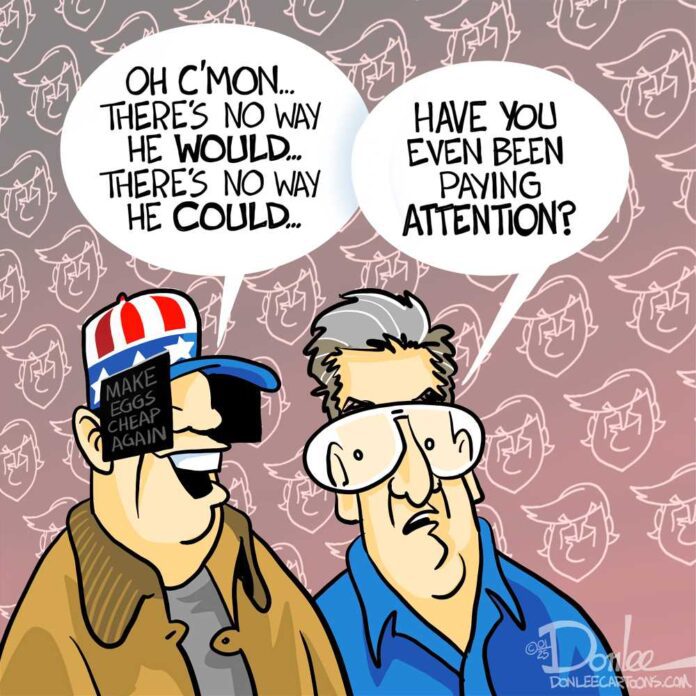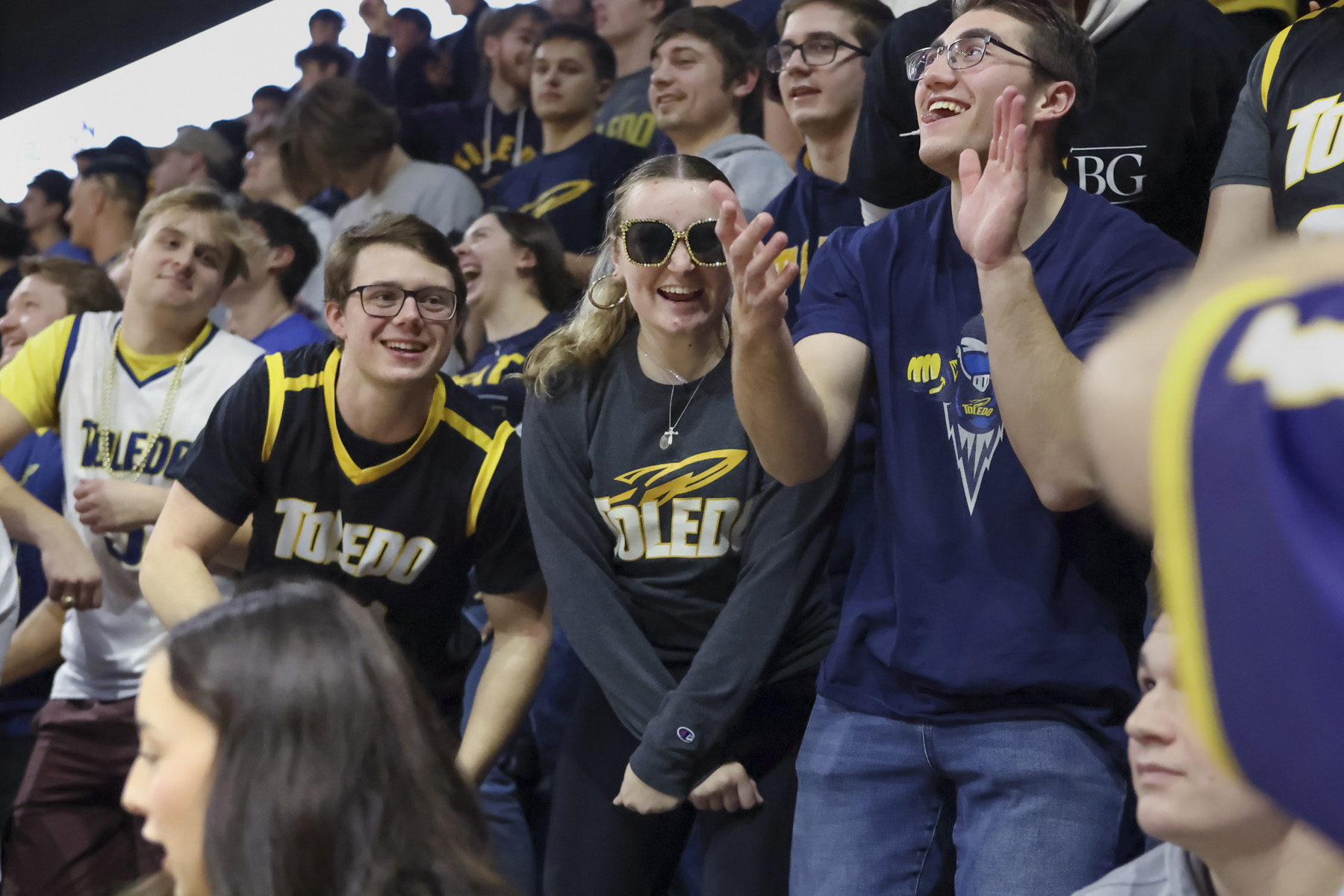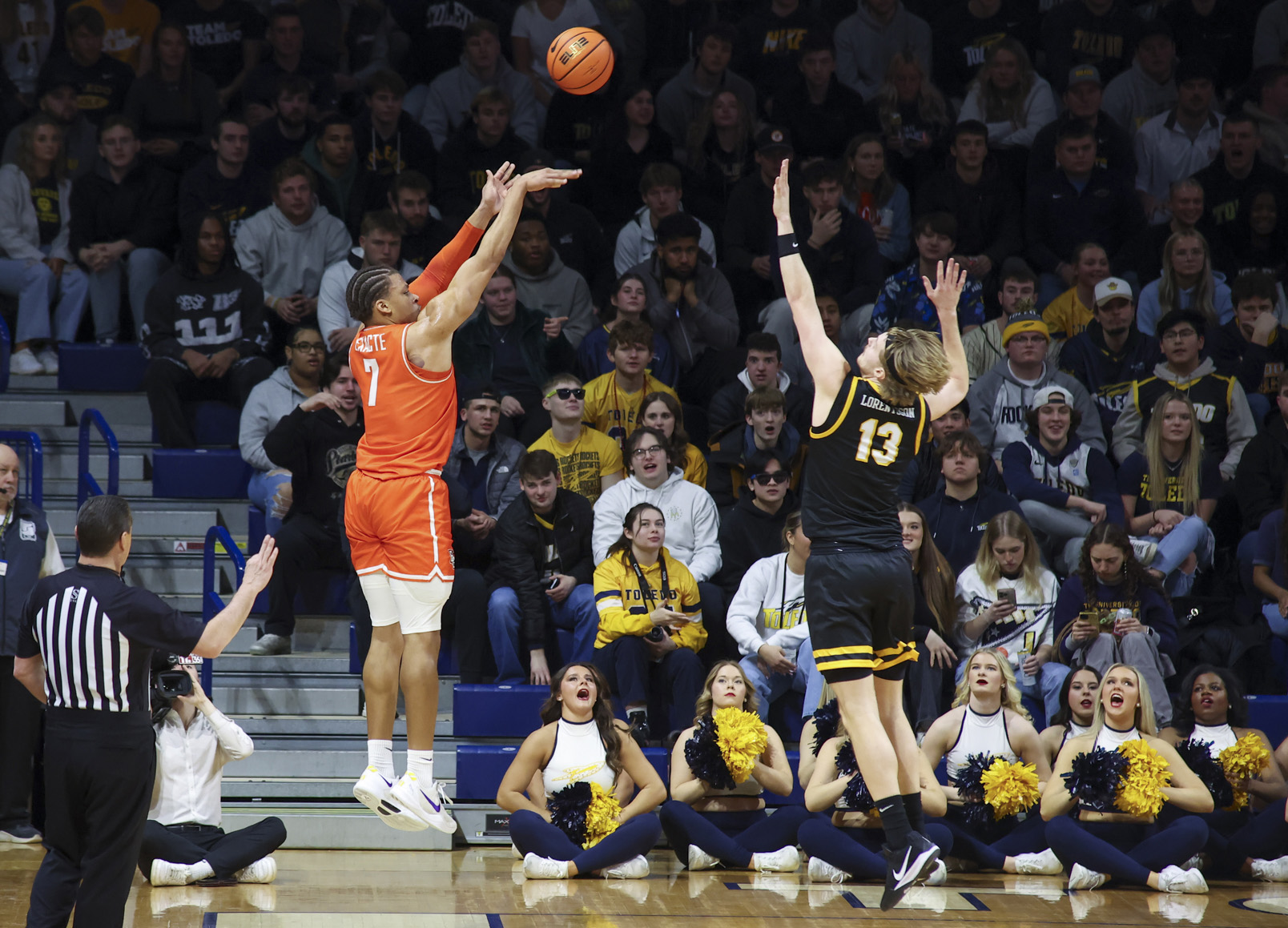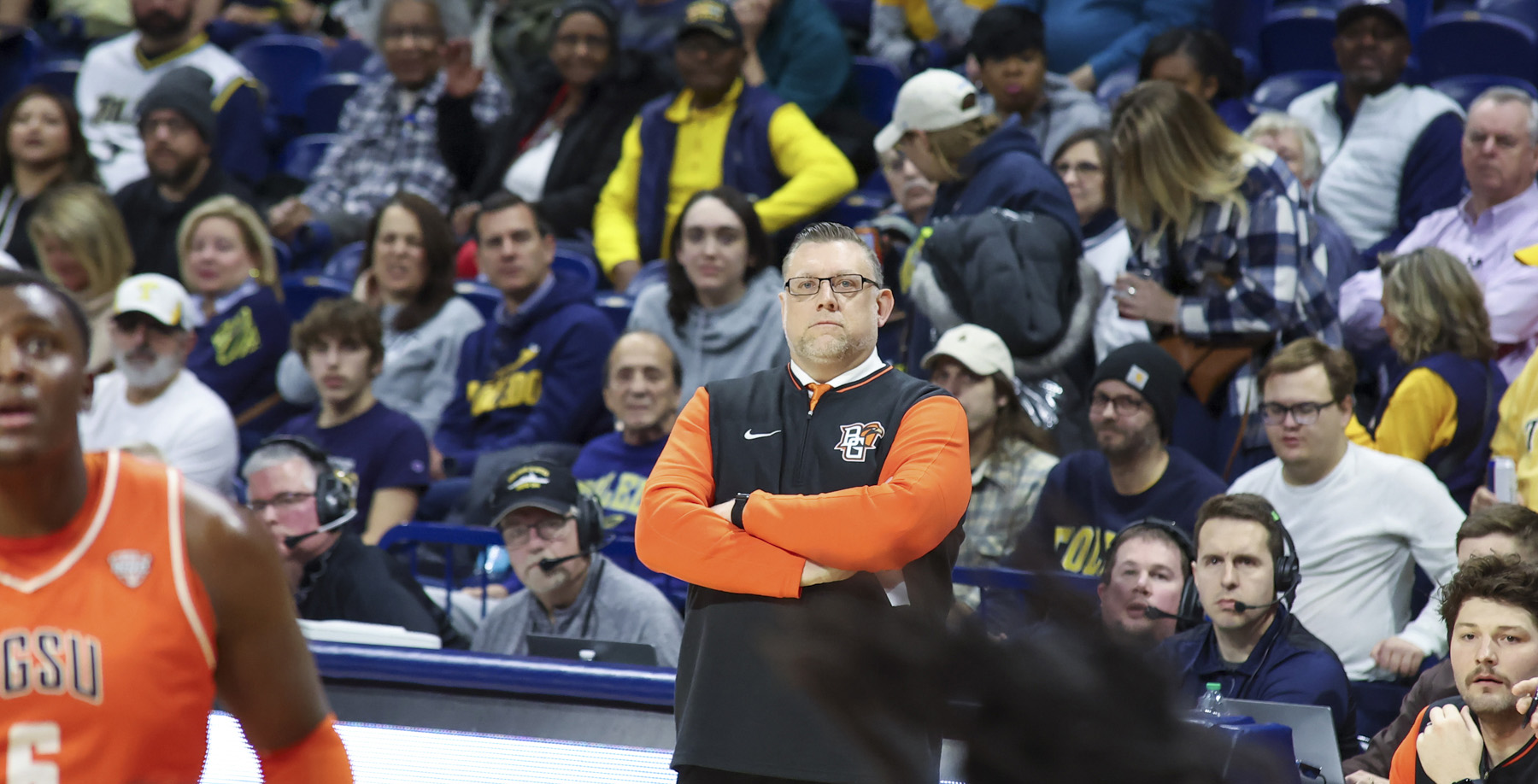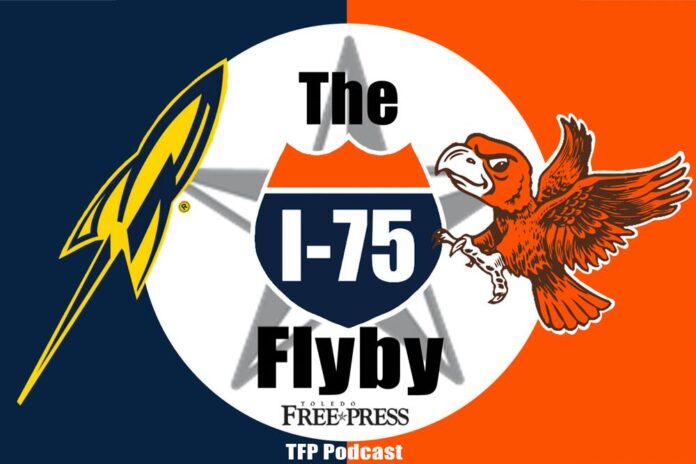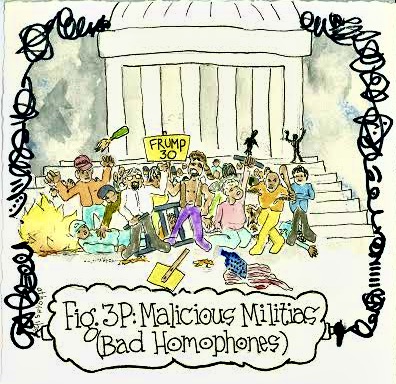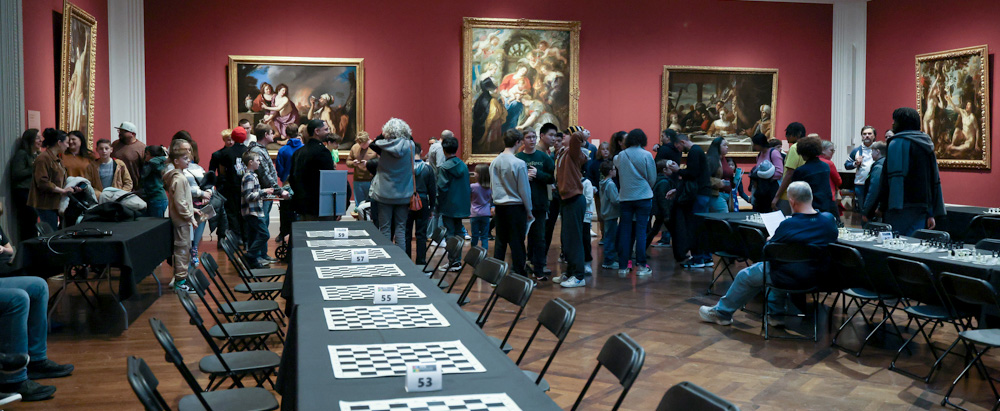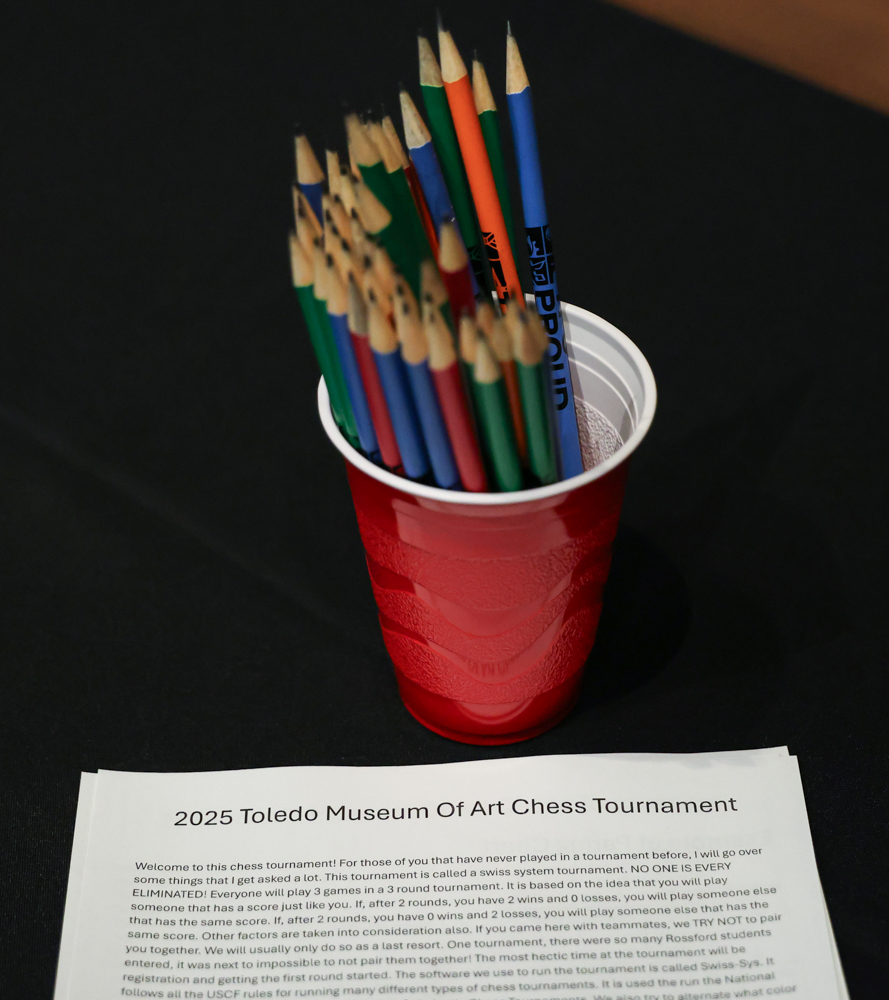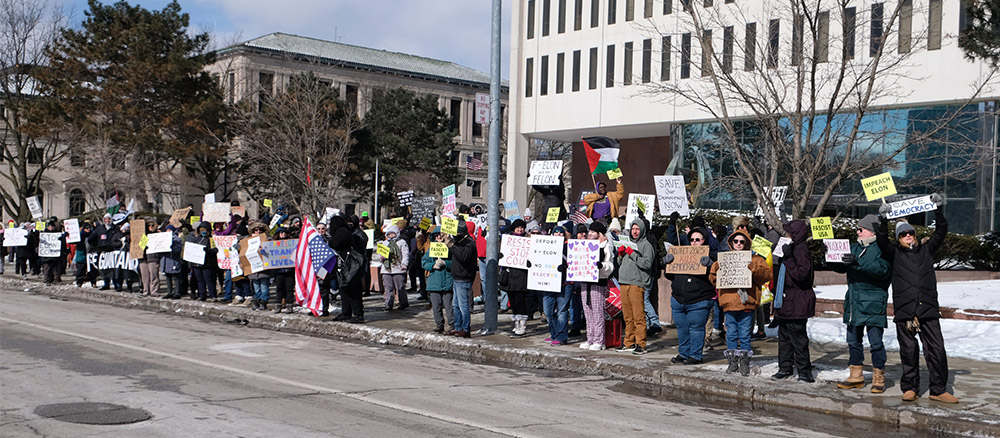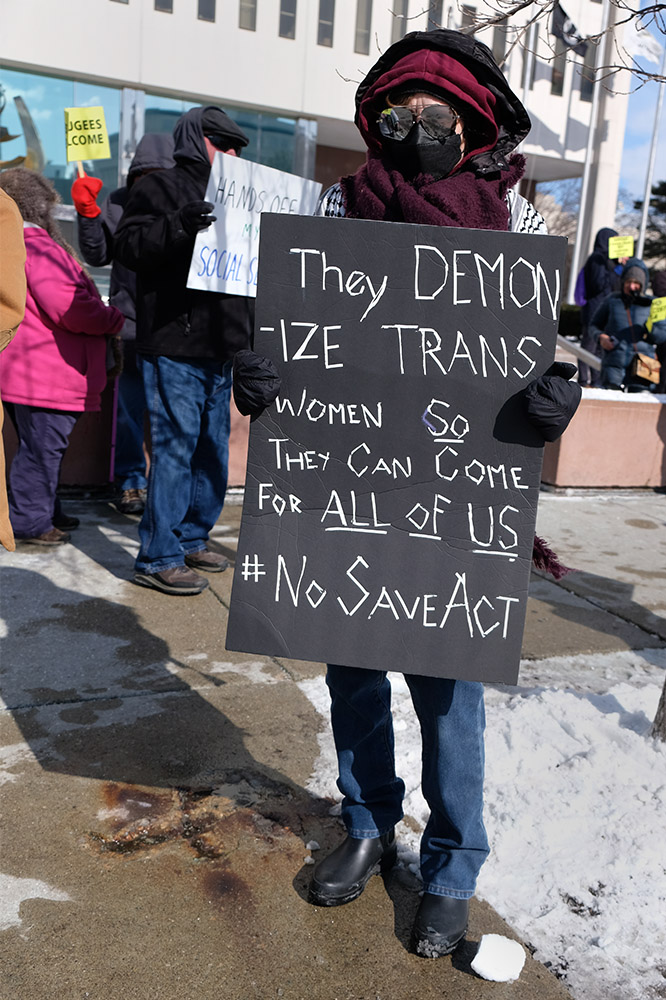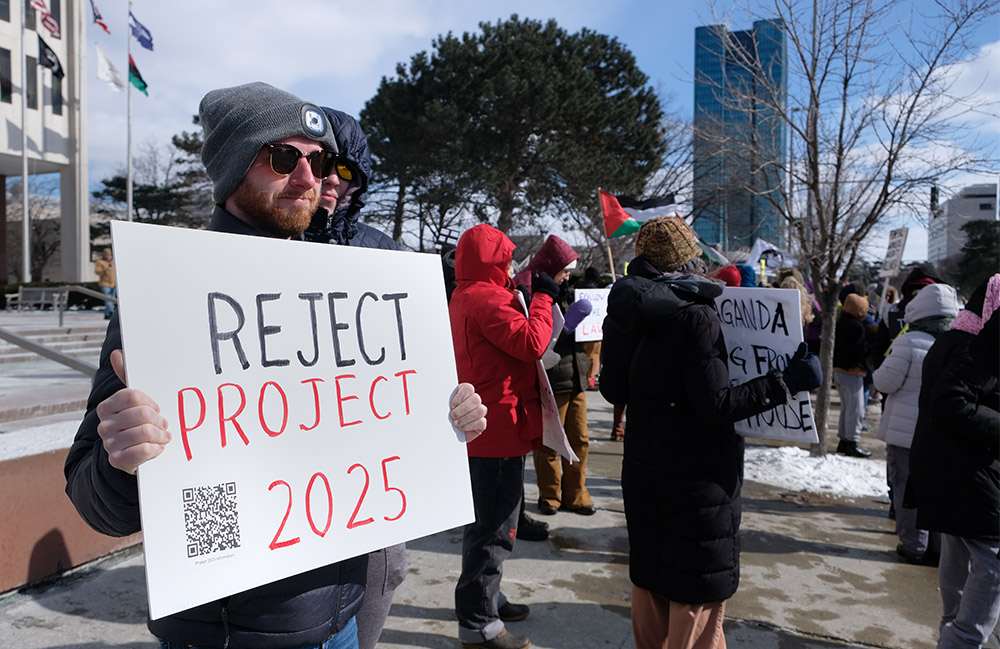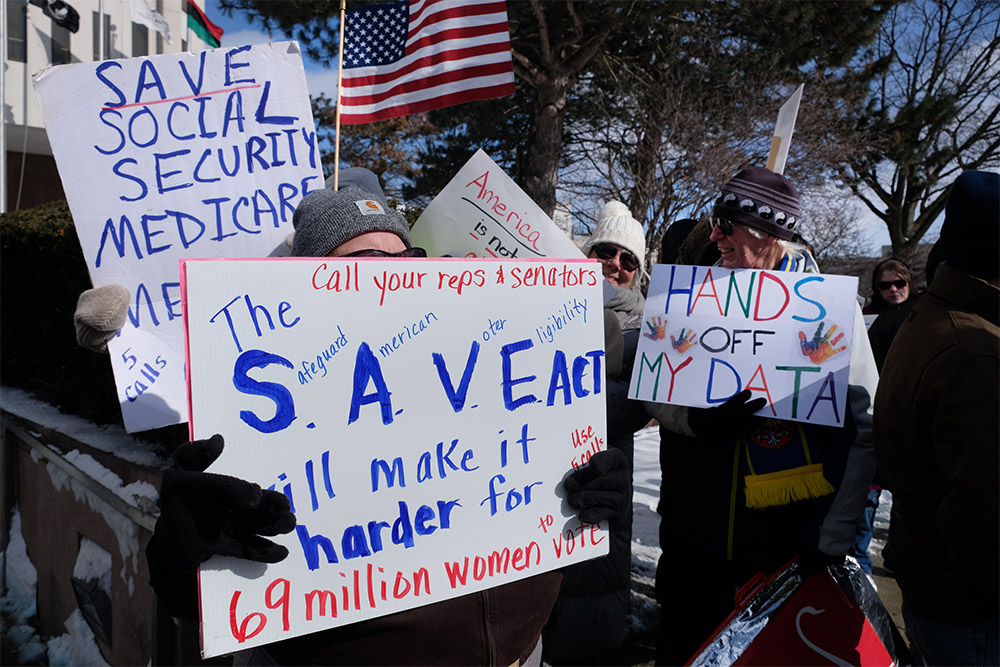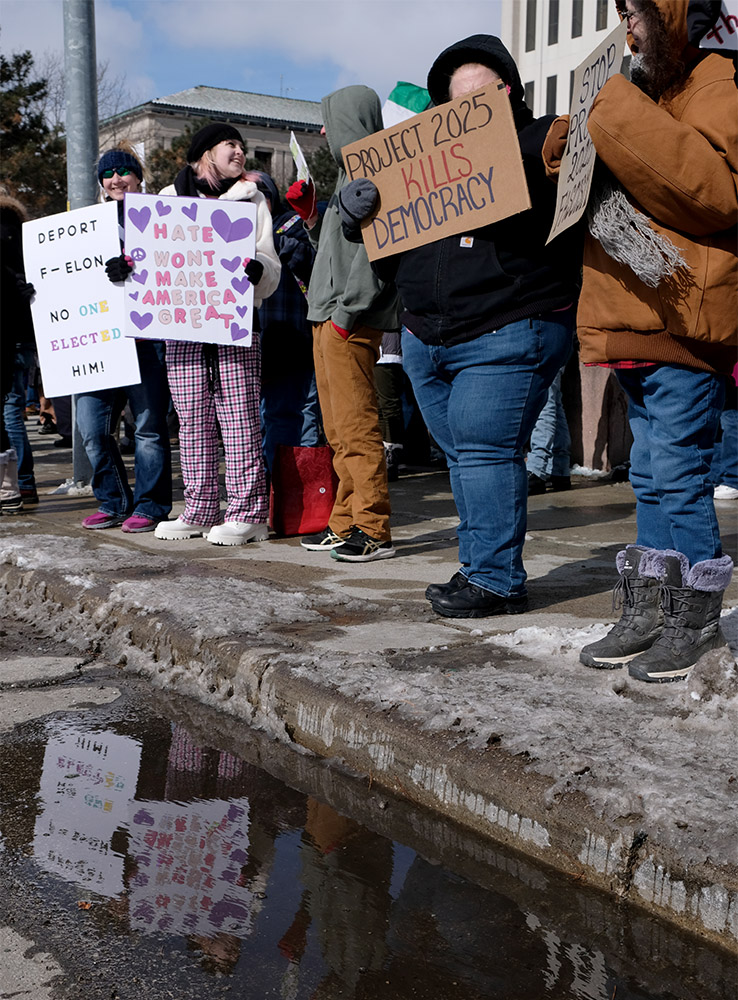BGSU stuns UT in last-second

Story by Max Alfonso | TFP Photos by Kyle Brown
TOLEDO – In a season loaded with injuries, Bowling Green pulled off an upset against Toledo behind a Javontae Campbell put-back layup in the final seconds to win 69-68 Friday night.
Bowling Green walked into Savage Arena 3-7 in their last 10 games not having won in Toledo since February 2021.
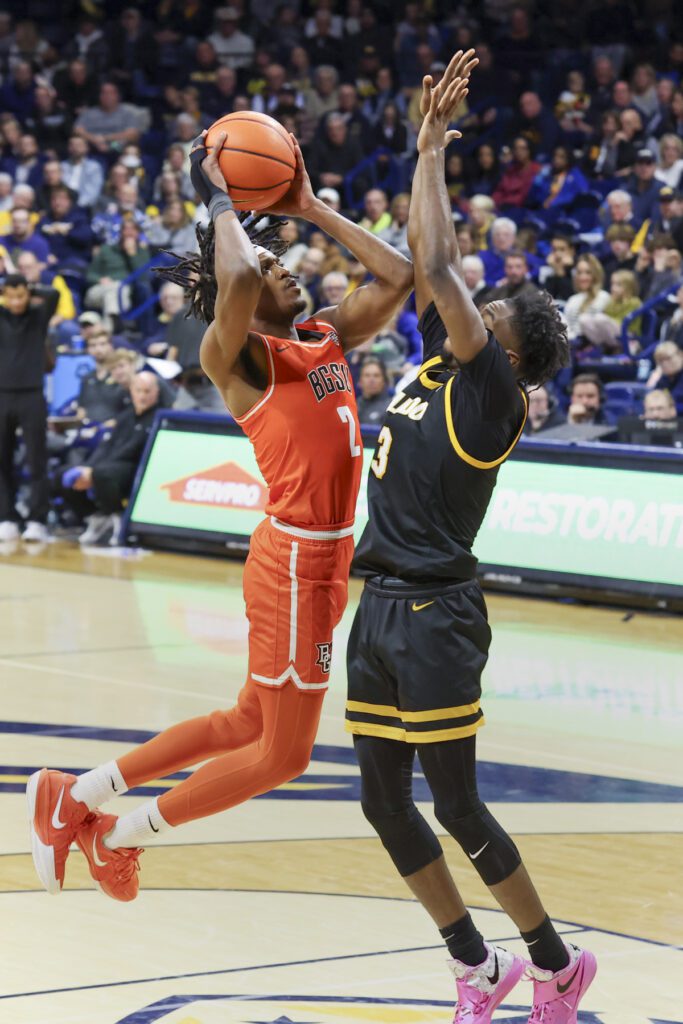
Before the game, Jon Rothstein, of CBS sports, announced Bowling Green starting guard Trey Thomas would miss the rest of the season with a broken leg, adding to a lengthy Bowling Green injury report with Sam Towns and Yousef Kahayat already out for the year.
“We practiced 3 on 3, with managers, coaches playing; it’s just a hard situation. Some guys are just games only,” he said.
Derrick Butler had 20 points for Bowling Green and played all 40 minutes. He moved into the starting lineup for Javontae Campbell, who is playing with a hand injury that has kept him out of practice since Jan. 6. They combined for 43 of Bowling Green’s 69 points.
“Derrick has been doing a great job for us, he’s given us a scoring punch off the bench,” BGSU head coach Todd Simon said. “We want to stagger some of these lineups, especially when you’re shorthanded, to make sure you have some scoring.”
Sam Lewis gave Toledo the lead with 15 seconds left when he went 1-2 from the free throw line to make it a 68-67 lead. Toledo only led for 5:02.
Simon called timeout with 15 seconds left and down 1. He drew up a play getting Campbell to the basket. He missed the layup; Wilguens Exacte missed a putback; Marcus Johnson missed a put-back; it was deflected to Exacte who passed to Campbell who made the layup to give Bowling Green the lead.
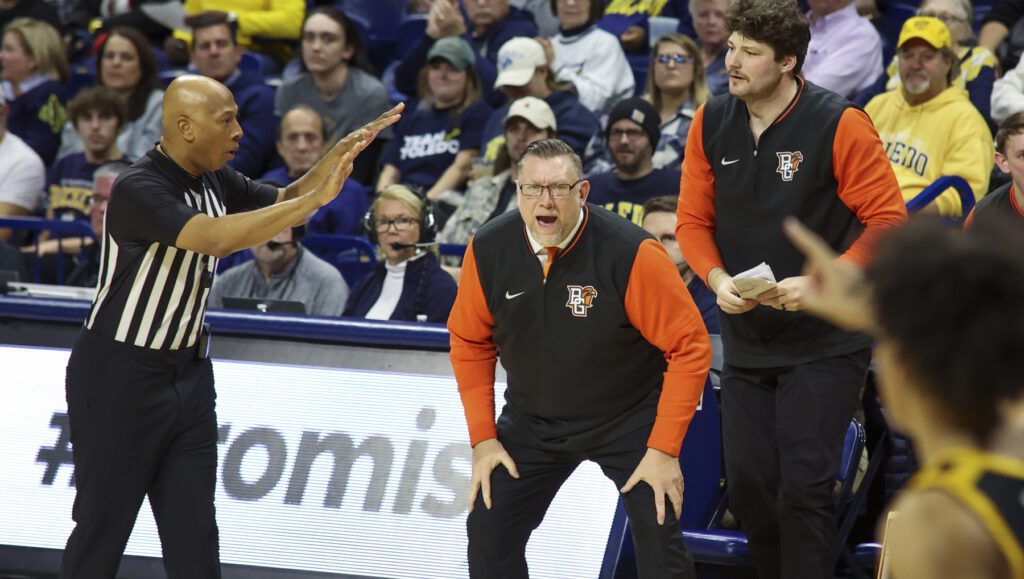
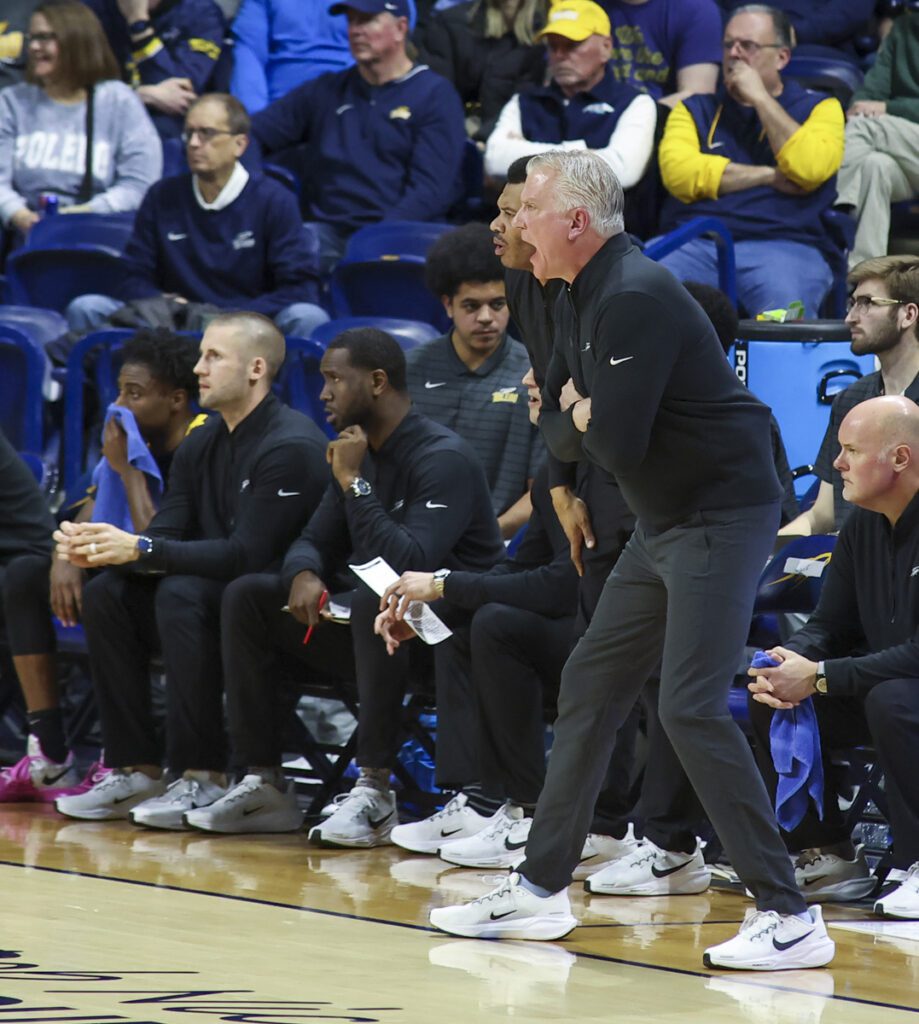
“I wanted to get a quick shot just so if I did miss, we could get the rebound,” Campbell said.
Simon wins his second game in the battle of I-75 and his first at Savage Arena in front of a crowd of 6,837.
“With the transfer portal and all the changes that happened, rivalries still matter,” Simon said. “At least it does in our community, and it does to our guys.”
Toledo has now lost 3 of 4 and falls to 9-5 in the MAC. This is the first time Toledo has lost at least five conference games since the 2019-20 season.
“Disappointing loss. I never thought we got our typical Toledo run. We never got that 10 nothing run,” Toledo Head Coach Tod Kowalcyk lamented.
Sonny Wilson had 13 points for Toledo, his third straight game under 15 points. Before that he had eight straight games with at least 15 points.
Toledo is back in action on Tuesday at Kent State. Last time they played each other, the Rockets lost 83-64. It was their largest defeat in conference play this season.
Bowling Green travels to Eastern Michigan on Tuesday for another must-win game. The Falcons currently sit 9th in the MAC. The top eight teams make the MAC tournament in Cleveland. Eastern Michigan is currently 8th.

Battle of I-75 roundup
On this episode of The Flyby, co-hosts and school rivals Chas McNeil and Max Alfonso dive deep into the longtime rivalry between the Falcons and Rockets in all sports, including stats, scores and predictions. They also recap last week’s sports news and update you on the play schedule for this upcoming week.
Both students are spring journalism interns at the Toledo Free Press.
New episodes of the The Flyby Sports Podcast drop every Saturday.
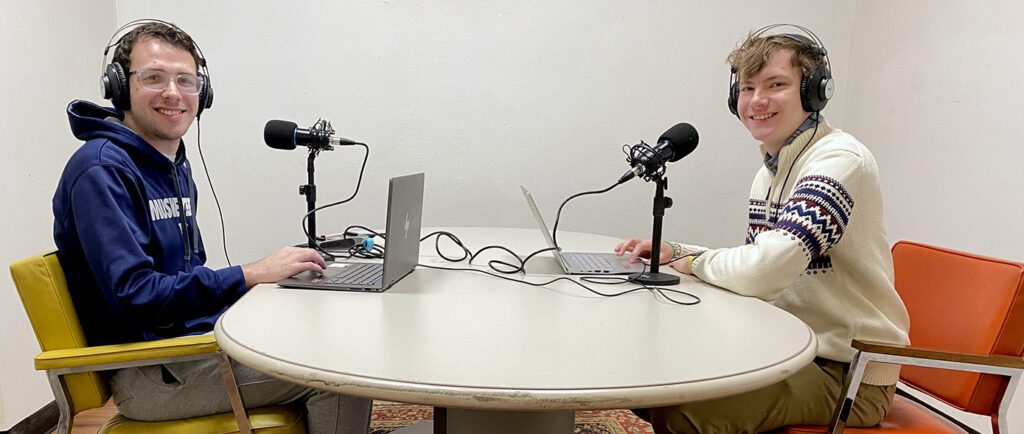
WHAT’S UP? Restaurant Week

Leadership Toledo’s Anna Toney touts 15th annual charity event
TOLEDO – It’s time for the 15th Annual Restaurant Week! As Toledo eateries prepare their specialty menus for a deluge of curious, thrifty and adventurous palates, customers are busy figuring out which of the 40 restaurants they want to sample.
Organized by Leadership Toledo, the week-long event, which begins Monday and ends March 2, benefits the program’s fundraising efforts for youth involvement in our city. To get a grasp of the growth of the event and its financial contribution to charity, the Toledo Free Press caught up with Anna Toney, executive director of Leadership Toledo, who gave us insight in the event’s overall contribution.
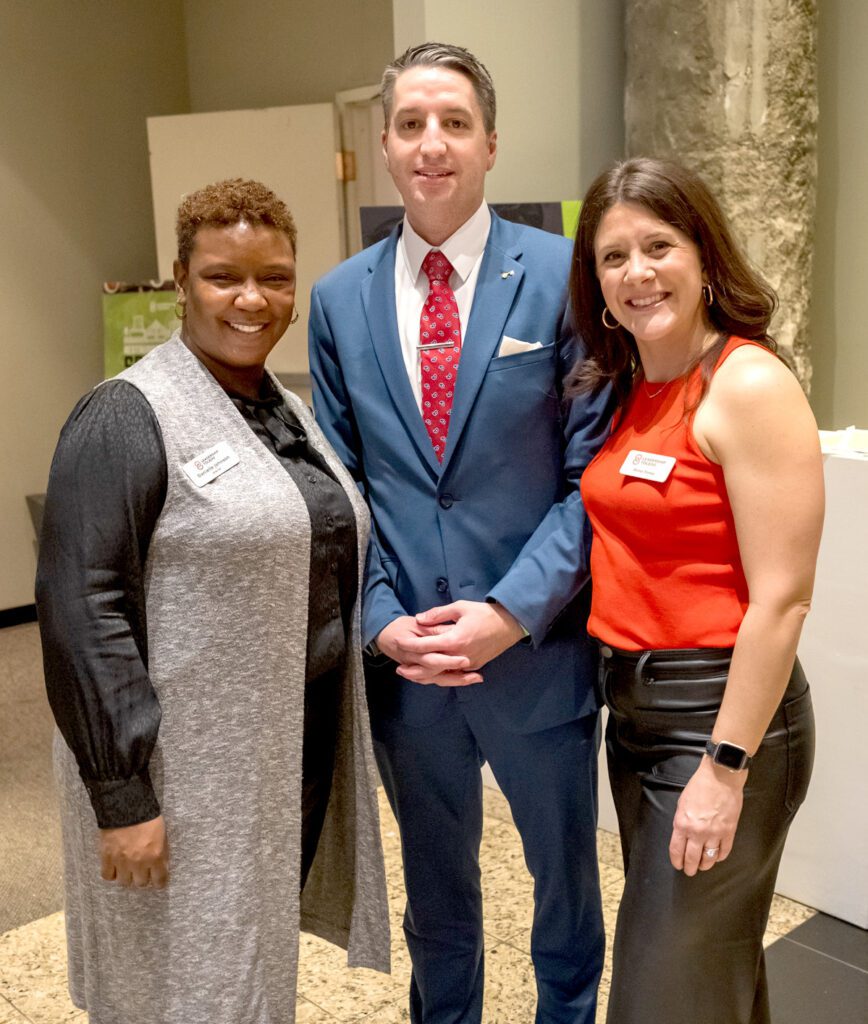
Ian Hubbard: What has been the impact of Restaurant Week since its inception?
For us, it’s one of our largest fundraisers to support our tuition-free youth programming. Since 2010, this fundraiser has raised over $1 million. Many restaurants tell us it’s one of their busiest weeks of the year. What began with a dozen restaurants has grown to over 40! I’ve been with the organization since 2012 and it’s been incredible to see how it has evolved. We’re excited for another fantastic week!
Is there a metric you use to trace the event’s impact? Is it feedback from the community?
We measure the impact primarily by the dollars raised. The feedback we receive from community members and local restaurants is incredibly heartwarming. It reinforces how much our community values coming together to support locally owned businesses.
Is Leadership Toledo primarily a youth program?
Youth Leadership Toledo is a nine-month experiential program that brings together nearly 60 high school sophomores from over 30 area high schools. The program is designed to inspire community involvement and help students recognize their vital role in shaping the future of our communities.
Do you have any personal favorite participating restaurants or dishes?
Hard to choose! Local Roots offers really fun and tropical dishes during the event. I’m excited to try some new partners this year, like Regalo and Bluewater Grille. I do a lot of coffee meetings, so all of the coffee shops will be high on my list!
What is a misconception locals should get over when dining at these establishments?
The colder months are often the slowest for the restaurant industry, so supporting them makes a big impact. We always say it’s a win-win-win – for the restaurants, for customers enjoying great deals and creative menus, and for Leadership Toledo. Additionally, it’s important to know that you can order off the Restaurant Week menu or the regular menu, and it still benefits the fundraiser.
Locally owned recommendations
If you want to spend a day during Restaurant Week playing the role of “townie,” here are a few selections to get you from breakfast to dinner:
Maddie & Bella: Start the day off right with a slice of in-house coffee cake and a Cup of Joe (or tea, if you prefer less of a jolt). I’m fairly basic when it comes to caffeine – a hot coffee with a touch of cream always does the trick. If you want to be fancy, try their homemade scone, smeared in jam, and a hot matcha latte.

Balance Pan-Asian Grille: If you’re looking to change it up, the Mongo and Korean BBQ tacos are light fare for your money. Ask for two of the red dipping sauces. The mix of savory between the proteins and spiral-cut vegetables and the heat of the sauce is a tip-top combination. Grab an order of their Eye of the Tiger butterfly tea. The sweetness of the passion fruit, pomegranate and lemonade mix will cleanse the palate.
Home Slice Pizza: If you don’t want to venture away from downtown and crave a classic combination, there’s this St. Clair staple. I’ve had many pies there, and they’ve always hit the spot. Restaurant Week will see Home Slice offer two for $25 combos (large pizza and appetizer/dessert), as well as a Nashville Hot Chicken Pizza and a Spicy Meatball Pizza to benefit the event.
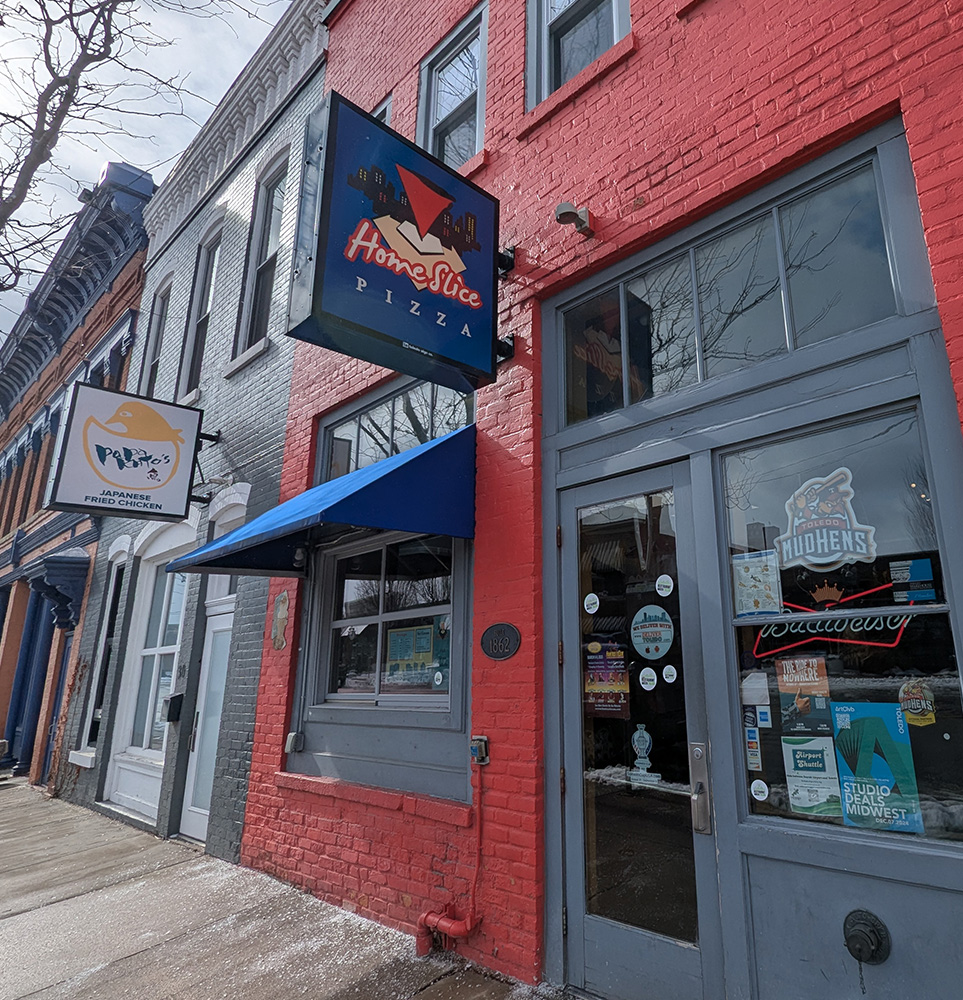
Souk Mediterranean: You’ll have to stop home for a nap and change into your Saturday night attire before heading to Souk’s fine dining atmosphere. They’ll offer a three-course dinner (or a two-course lunch) in benefit of Leadership Toledo. In case that doesn’t fit your bill, I recommend the Roman Mussels to start, followed by either the Lamb Ragu or Garlic Roasted Duck Breast for your entrée.
For a full list of the participating restaurants and their specialty menus, go to restaurantweektoledo.com.
Toledo Golf Show opens in Sylvania Friday – Sunday
SYLVANIA – The Masters Tournament historically signals the start of the golf season, but for Toledo-area golfers, there is one more important sign that spring is not too far away — the Toledo Golf Show.
Every year, the Toledo Golf Show provides area golf fans a chance to purchase new clubs, apparel, and book golf trips to their favorite resorts at discounted pricing. In addition, golf experts will be on hand to answer questions and give tips to improve your game.
This year the show will kick off at 3 p.m. on Friday at the Tam-O-Shanter Sports & Exhibition Center in Sylvania.
Friday Events
To get the show started, John Ambrose, director of instruction at Hemlock Springs Golf Club, will speak about Pendulum Putting on the big stage at 4 p.m. At 5 p.m., Tony Walters, head teaching professional and Callaway professional club fitter, will talk about the benefits of proper club fitting.

Local golf professional Dan Sutton will offer tips to lower everyone’s score. And to round out the evening, the Girl Scout Cookie Eating Contest, sponsored by The Legacy, will begin at 7 p.m., with the doors to close at 8 p.m.
In addition, Tony Packo’s, Inside the Five and Treu House of Munch will be on hand with all their favorites, plus adult beverages can be purchased on the show floor.
Saturday Events
The fun continues on Saturday as the doors open 9 a.m. – 6 p.m. Zoom Broom’s Randy Kuckuck, professionals Janet Rychnovsky and Andrew Headman will give golf tips to help increase your enjoyment. At 2 p.m., former PGA Tour winner and Toledoan Pat Lindsey, the keynote speaker, and will regale golf fans with stories from the tour. Other local pros will take the stage to talk golf, and the day will close with the Nothing Bundt Cake Blindfolded Cake Tasting Contest.
Sunday Events
On Sunday, Rychnovsky, Dale Perne, Ambrose and Sutton will offer more golf tips from the stage. At 3 p.m., Tony Packo’s will host their popular Pickle Eating Contest.
Every year, Andrew Brown, owner of the Toledo Golf Show, awards a check to a local charity from proceeds of the event. That will take place at 3:30 p.m. just before the doors close at 4 p.m.
Word to the wise: get there early for the best prices and widest selection of equipment and apparel. Get a jump on your buddies this year. Look good and play better, but remember — the early bird gets the best deals.
Tickets are available at the entrance for $7, but patrons can save $1 by purchasing from one of eight area locations, or online at ToledoGolfShow.com. Children under the age of 12 and parking are free.
Guide to live local comedy
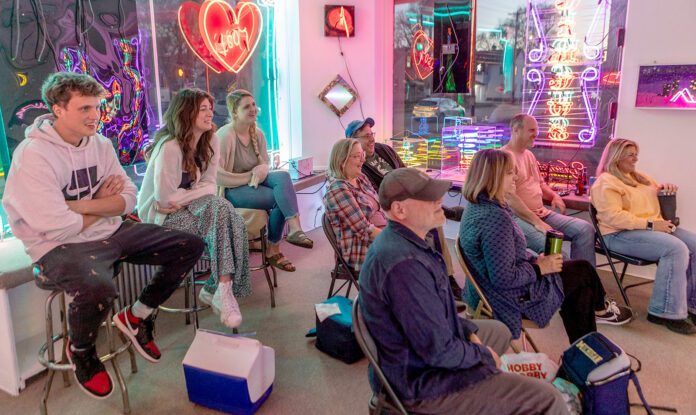
Local venues give comedians chance to work on their craft
TOLEDO – Emily Garrow does not have fond memories of her first time on stage.
She was there hoping to be funny. Tell a few jokes. Make the audience laugh. It was Garrow’s inaugural moment to either sink or swim as a budding comedian.
“Funny people should just be left to be funny.”
Late comedian Patrice O’Neal
“It was open mic [night] at the Ottawa Tavern on Adams St.,” Garrow recalled. “It was kind of open to anyone who walked in and signed up. I had watched a few times and got brave enough to go up on stage.
“My first time was pretty terrible. My jokes were just not all there yet and the microphone went out and not everyone could hear me. I didn’t get very many laughs and I went home and cried.”
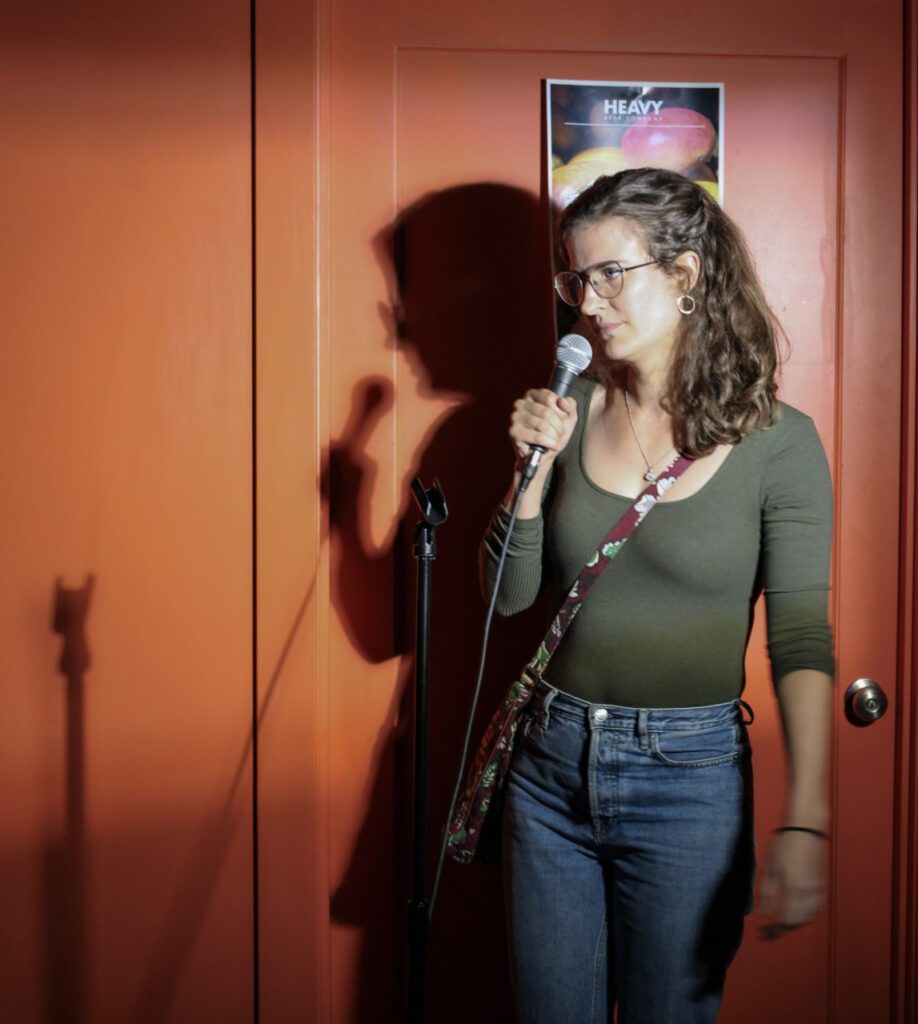
That was three years ago, and though the Ottawa Tavern permanently closed in December, Garrow continued with comedy – and now her prowess as a comedian has done a 180.
Comedian Dave Crumbley persuaded Garrow to take her shot on stage that night at the Ottawa Tavern. Crumbley is the executive producer and talent coordinator for Crumbley Comedy, which promotes shows at small venues around Toledo.
Garrow is one of 90 comedians Crumbley Comedy promotes locally.
“Emily is an incredible joke writer,” Crumbley said. “With Emily everything is earned and honest. A brilliant joke writer. No mess on it. It’s spotless.”
Crumbley wasn’t a class clown growing up. He had a “terrible” stutter until age 10 or 11 and said he was fascinated with anyone who could speak confidently to an audience. He loved pro wrestling and enjoyed listening to entertainers like Howard Stern, people who could confidently communicate to a mass audience.
“Stand-up is hard in general,” Crumbley, 39, said. “It takes years to get really good. A good stand-up comedian communicates effectively with confidence and knows exactly where the line is every night.”
As of 2024, there were an estimated 1,072 comedy clubs in the United States. Levis Commons in Perrysburg is the site of one national brand, The Funny Bone (formerly Fat Fish Blue) and regularly brings in national acts, such as DL Hughley.
“They are the big dog,” Crumbley said. “They have stars over there. They are very intelligent business people.”
Other comedy venues
Garrow and her fellow local comedians perform at smaller, non-traditional venues around Toledo, such as Home Slice Pizza, Chevy’s Place, Jake’s Saloon, Bent Custom Neon, Toledo Tech Loft, Great Black Swamp Brewing and Earnest Brew Works, which has locations in downtown Toledo, Westgate, and south Toledo.
Most of the shows are free.
- Free shows are held Sundays at Home Slice Pizza – it recently increased capacity by 20 by expanding to the heated and enclosed patio for their shows
- Tuesdays at Chevy’s Place
- Thursdays at Jake’s Saloon
- Crumbley said they also sell ticketed shows with headliners at Bent Custom Neon and Toledo Tech Loft.
As many as 200-300 people attend some of these events on any given week, Crumbley noted, but most of the establishments seat around 50 people per show.
Crumbley serves as host – he estimates he’s hosted 1,200 shows over the last several years – and does about five minutes of stand-up before introducing each comedian on stage.
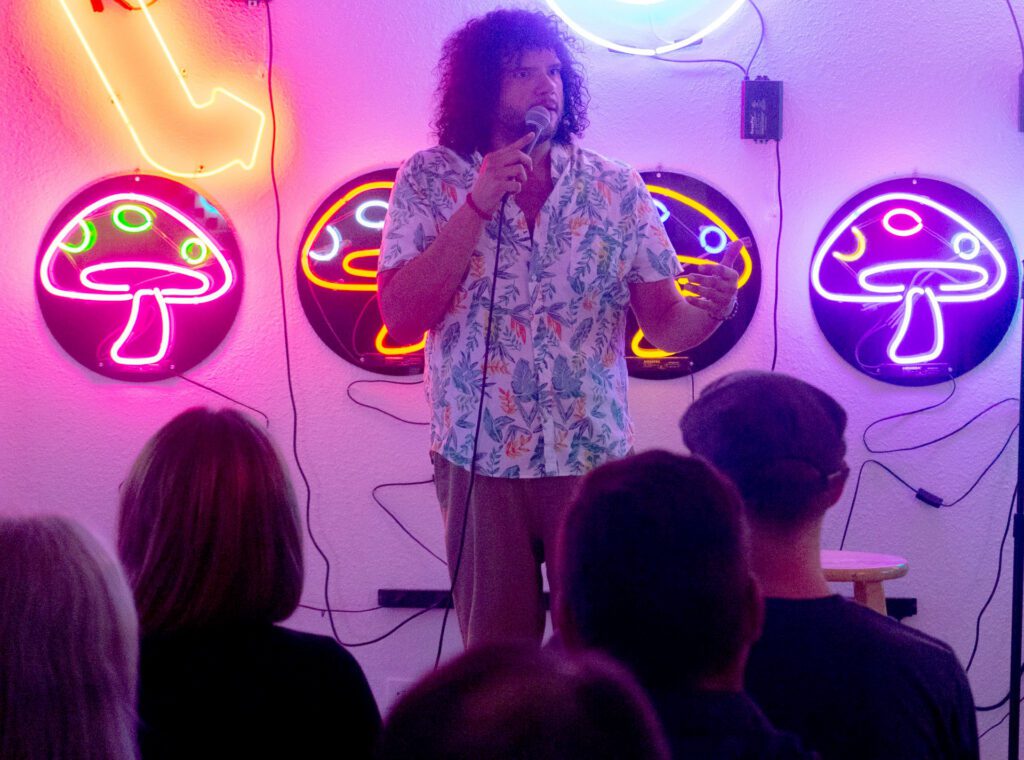
“As a host, all I care about is the show being good,” he said. “We will send 15 comedians on stage at the free shows, doing five-minute sets. We’ve had comedians who are regulars at Ann Arbor Comedy Showcase, like Brad Wenzel, who was on Conan O’Brien’s show three times.
“Getting professional comedians to come out to open mics, they set the tone for our local crew. They learn from these people who are super accomplished,” he said.
Besides Garrow, some other regular local comedians include Miss DivaNae, Tha Grizz, Van Morgan and Casey Heller.
Garrow, 34, a native of Temperance, Mich., works as a dental receptionist and said she really started to “hone in” on her stand-up routine early last year. She teams up with Crumbley for about four to six shows a month.
“I’m pretty awkward in real life and I have terrible anxiety,” Garrow admitted.
“I appreciate Dave for pushing me. He wouldn’t put me on a booked show until I could show up on stage without a notebook. Shout out to Dave for taking up the comedy scene locally and giving comedians an opportunity to practice and get good,” said Garrow.
For more information on local comedy shows, visit crumbleycomedy.com.
Girl Power inspires STEM involvement
TOLEDO – Striving to inspire future female innovators, Imagination Station is hosting Girl Power on Saturday in an effort to inspire more girls to embrace STEM.
While nearly half of the U.S. workforce consists of women, women make up only 27 percent of the STEM [science, technology, engineering, math] field, according to the United States Census Bureau.
Girl Power, an annual event, is an attempt to change those statistics by teaching young girls more about science and encouraging them to pursue a career in STEM.
One way Imagination Station hopes to foster this is through an inspiring speech from keynote speaker Stephanie Finoti.
Finoti, 2024’s Miss Ohio in the Miss America program, has a bachelor’s degree in biomedical science and is working towards becoming a pediatrician.

“I really hope to show these young girls that you can truly embrace your femininity and also be intelligent and a leader,” she said.
Finoti said she hopes exposing young women to STEM will encourage them to “bridge the gap in STEM in the future.”
Sloan Eberly Mann, chief education officer at Imagination Station, said Finoti challenges the traditional stereotypes.
“She has a very broad range of interests, and I think she shows that you can be girly and love makeup and dresses and all the things that are emblematic of being Miss Ohio, and then you can still pursue these really serious, rigorous science courses and be successful in that, as well,” Mann said.
In addition to the speech, there are working women professionals on hand, workshops and hands-on activities to enhance learning.
“Being able to show them these hands-on activities gives them a glimpse of what a day in the life of this career looks like. And it gets them more interested in the actual subject itself,” said Finoti.
Another way the event strives to encourage female interest in STEM is by encouraging younger girls to get involved, piquing their interest in STEM early on.
“The vast majority of children, young girls, who demonstrate an interest in the sciences will lose that interest in middle school,” said Mann.
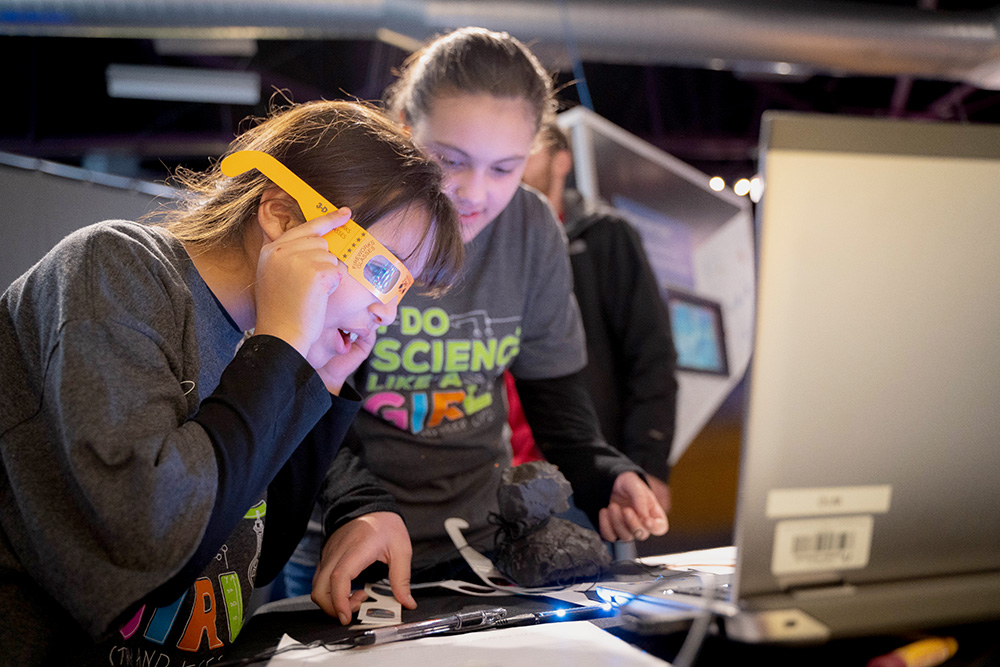
“We’ve actually heard back from parents and kids (who said) it set them on the track to pursue the sciences in college. It’s just an exciting, fun day that reinforces our mission that science should be accessible to everyone,” Mann said.
“I hope that students can take away not only a love for STEM and the arts, but to also feel empowered and motivated, and that they can truly become anything they set their mind to doing,” said Finoti.
More information about Girl Power can be found on Imagination Station’s website.
More information about Girl Power can be found on Imagination Station’s website.
The Girl Power event is on Saturday, March 8, from 9:30 a.m. to 5 p.m.
Chess prodigy speaks at Strategic Interplay Chess Tournament at TMA

TOLEDO – Tani Adewumi was introduced to chess at age 7 by his older brother, Austine Adewumi, when their family lived in a homeless shelter in New York City.
One year later, Adewumi won the K-3 New York State chess championship. Sound implausible?
Now 14, Adewumi is a high school freshman and plays guard on the basketball team. He is rated one of the best young chess players in the world, with an international rating of 2362 and a rating of 2436 with the U.S. Chess Federation; it’s a rating high enough to earn him National Master (NM) status.
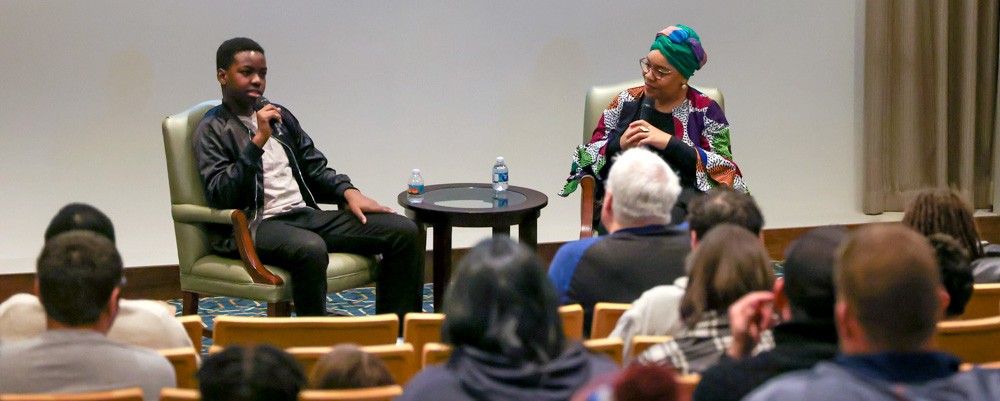
To put those ratings in perspective, a chess Grand Master (GM) typically has an FIDE rating of at least 2500. FIDE is the governing body for international chess. To become a GM, a player must also achieve three favorable tournament results, called norms. Adewumi is determined to become a GM sooner than later.
He said chess has always captivated him because “it’s so creative and keeps giving you new ideas.
“It’s infinite, the amount of ideas and creativity,” said Adewumi, known for his aggressive style of play. “Chess is creative. That’s why I like it. There are an infinite amount of (game) openings – everything about chess is pretty good.”
Adewumi was the guest speaker on Feb. 15 at the Strategic Interplay Chess Tournament at Toledo Museum of Art. The tournament was sponsored by TMA, Toledo Public Schools, and Warren and Yolanda Woodberry of the Woodberry Park Chess Club at Jones Leadership Academy in Toledo.
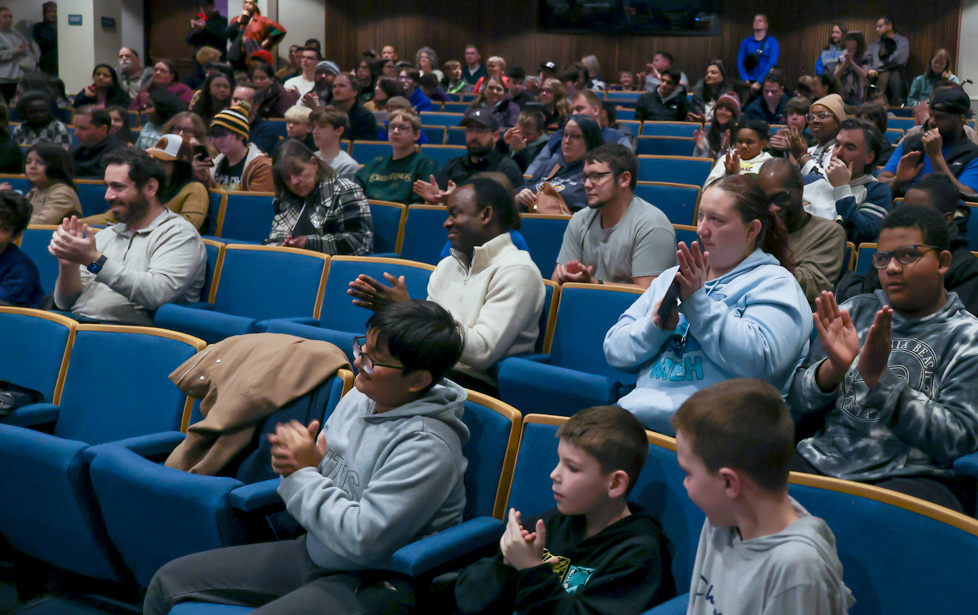
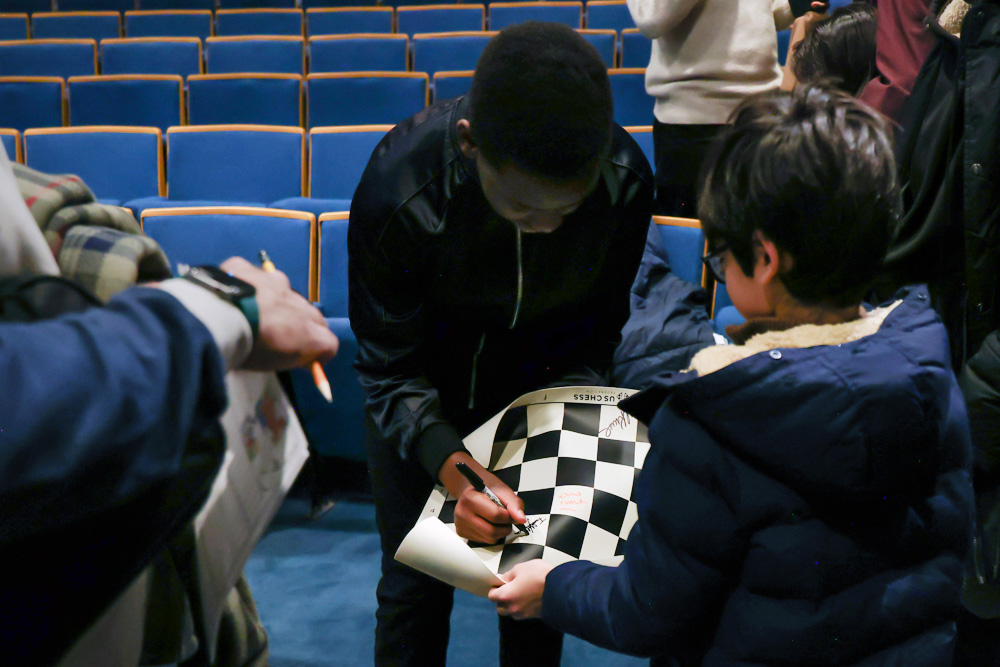
Adewumi, Austine Adewumi, 20, and their parents, Oluwatoyin and Kayode Adewumi, immigrated to the United States from Nigeria in 2017. They were forced to flee their homeland due to religious persecution and lived in a shelter in New York for some time.
The family still lives in Manhattan, where the family patriarch, Kayode Adewumi, is now a licensed real estate salesperson.
Prior to the start of the Strategic Interplay tournament, Tani Adewumi was the guest in a 45-minute Q&A session with moderator Lanisa Kitchiner, curator of African Art at the TMA. Approximately 150 chess fans, children and adults, attended the session in the museum’s Little Theater to meet and talk with the young prodigy.
Kayode Adewumi said he and his wife realized just how prodigiously gifted Tani Adewumi was at chess when, as an 8-year-old, he won the K-3 New York state title in Saratoga Springs.
“He signed up to play chess at school in 2019, and he loved chess,” said his father. “As parents, we encouraged him. He loved it with a passion. When he was 9 or 10, he practiced seven to eight hours a day. He learned chess and became a champion in one year.”
Kayode Adewumi said he is most proud of his youngest son’s consistency.
“Some kids may lose focus, but I love his consistency,” he said. “He knows what to do, with little advice from others.”
Tani Adewumi, who has has written four books, said he plays chess two to three hours a day, seven days a week. He has a chess coach whom he said he has never beaten.
Tani Adewumi has had countless stories written about him by a myriad of publications, including the New York Times, and has appeared many times on local and national television. Former president Bill Clinton and chess legend Garry Kasparov have raved about him.
At age 11, on live TV, Tani Adewumi said that “chess just came to me – just like a tennis ball comes to a racket.” He practices on a popular internet chess site, chess.com, every day and said he prefers to play other competitors online instead of playing against the computer.
“I’m always thinking about chess,” said Tani Adewumi, an honors student who does not have a cell phone. “School and education are really important. After I come back home from school, everything about chess is on my mind.”
During the Q&A session, a young chess fan asked him what goes through his mind when he loses.

“I can get mad at myself,” he admitted, “but it’s also a learning experience. You get stronger every game you play.”
Tani Adewumi has proven to be a tremendous chess ambassador, and he relishes the support he gets from his family.
“A support system is very crucial,” he said. “It gets you in the right mode and helps you relax and focus. You want to feel good after every single game.”
President’s Day sparks both public protest, private party
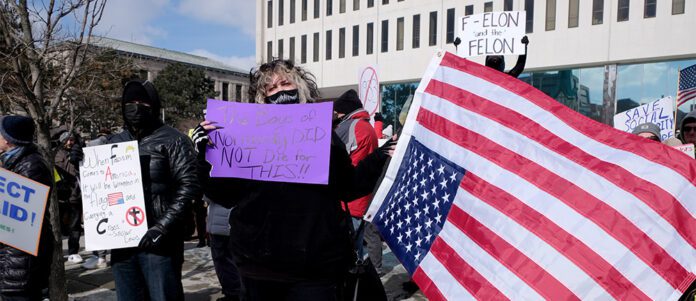
A deeper look into the politics of two sides
LUCAS COUNTY – President’s Day provoked strikingly different reactions from the local polarized political climate: One group publicly protested while the other held a private party.
Outside of 1 Government Center, the seat of government in Toledo, more than a hundred people on Monday braved the numbing winter winds to make their displeasure with President Donald Trump known. The National Day of Protest was in association with the 50501 Movement (50 protests. 50 states. One movement) against the Trump administration.
Susan Kuehn, an organizer with Northwest Ohio Peace Coalition, explained her group’s presence in front of the government building. “We are protesting against the Trump-Musk administration dismantling and taking over the federal government and federal agencies, and purging hundreds of thousands of employees without cause for their [Trump-Musk] own benefit.
“They’re attempting an unconstitutional act,” she added.
While there were many specific reasons for the protest, Elon Musk, who is unelected and unconfirmed by Congress but deep into the government’s business, seemed to be the main target of the protesters’ frustration.
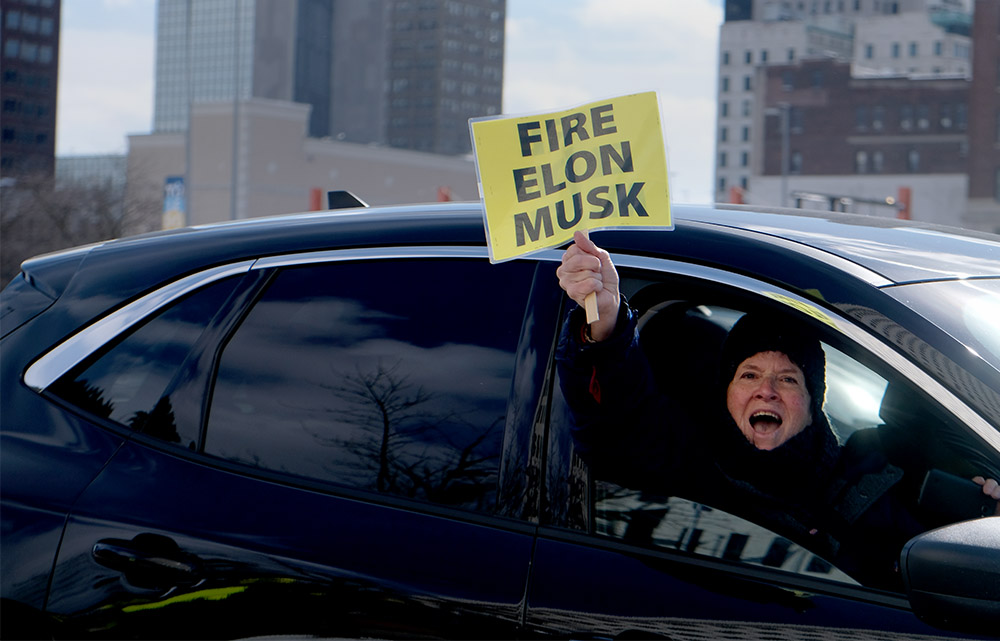

Trump unveiled his plan for the new Department Of Government Efficiency (DOGE) while on the campaign trail. During that time, the venture included Republican presidential candidate Vivek Ramaswamy, but when he stepped down from the role, that put Musk in the center seat of DOGE, formerly the United States Digital Service (USDS), and he began slashing government spending and regulations without approval from Congress.
Trump took office a month ago, and since then DOGE has gotten to work in a strikingly similar manner to how Musk gutted Twitter after he bought it for $44 billion.
It’s unclear how many government employees have been fired by DOGE, but the most recent effort included a call from the Office of Personnel Management to layoff all probationary employees, with no known cause for the layoffs, which could be counted into the hundreds of thousands.
The probationary period refers more broadly to employees who are still in their first two years of service within the government, or who may have taken a new position within the government, including promotions.
United States Senator Patty Murray (D-WA) responded from the United States Senate Committee on Appropriations and said, “There is nothing efficient about indiscriminate mass firings.”
The senator vouched for the estimated 220,000-250,000 probationary employees, saying that 56,000 of those employees were part of the Veterans Health Administration, and warned that “these firings are totally arbitrary – pushing out high performers and the promising next generation of our federal workforce who won’t be easily replaced.”
At the beginning of last week, Musk and Trump addressed concerns specifically about DOGE from the Oval Office, where Trump defended his choice to place Musk at the head of DOGE.
Trump said DOGE had already uncovered “billions and billions of dollars in waste, fraud and abuse,” with a grand total of $55 billion claimed to have been saved on the DOGE website.
Musk was busy, but so was Trump, having signed 65 executive orders since the beginning of his second term.
When expounding on the savings he claimed to have done for taxpayers, Trump pushed back against federal judges who have impeded his and Musk’s ability to go as far as they have wanted with the massive changes in the federal government.
These massive changes to the government have not been met with support by all.
When asked what made him want to come out to the Toledo protest, Ryan McConnell, of central Toledo, said, “You know, if nothing else, just that people realize what’s going on, that President Musk and MAGA don’t speak for all Americans, that people see the wickedness that’s going on, how the government’s backsliding into authoritarianism.”
The Republican Party’s party
The energy, intensity and discomfort of the protesters sharply contrasted with the Republican Party that gathered 11 miles away, in the suburb of Holland, Ohio. Held inside the Lucas County Republican Party Headquarters, GOP members celebrated President’s Day with food and games.
Red was the primary color of the event, and elephants were on display throughout the private party. “We had a dress as your favorite president contest, and we had a young man dressed as Teddy Roosevelt,” said Barbara Orange, chair of the Lucas County Republican Party, as she recapped the afternoon’s events.
When asked about Trump’s actions that have rattled the federal government, Orange said, “I think President Trump is fulfilling all the promises he made on his campaign trail.”
If there’s any waste or fraud that needs to be addressed it should be pointed out. And then, of course, Congress is the ultimate one to make a decision on any changes that would come from that,” she said.
Orange said that pausing funds may be necessary in the meantime to figure out where payments are going, and added she thought government should be approached like a business that needs to be audited.
These were the same conclusions Musk expounded upon during the Oval Office press briefing, where he pointed to the $2 trillion national deficit ($1.83 trillion, to be exact) as the reason behind his aggressive cuts.
Musk warned the cuts were “…essential for America to remain solvent as a country.”
Anecdotally, Musk pointed to payments made by the Department of Treasury without specific categorizations, calling them “blank checks,” and complained about the current processes associated with putting things on a “do not pay list” associated with the Office of Payment Integrity through the Payment Integrity Information Act of 2019.
“The people voted for major government reform,” Musk said when asked to respond to the criticism that DOGE was part of a hostile government takeover that was happening without transparency. He cited the Republican majorities in Congress and the popular vote Trump won as a sign and mandate for the changes happening now.
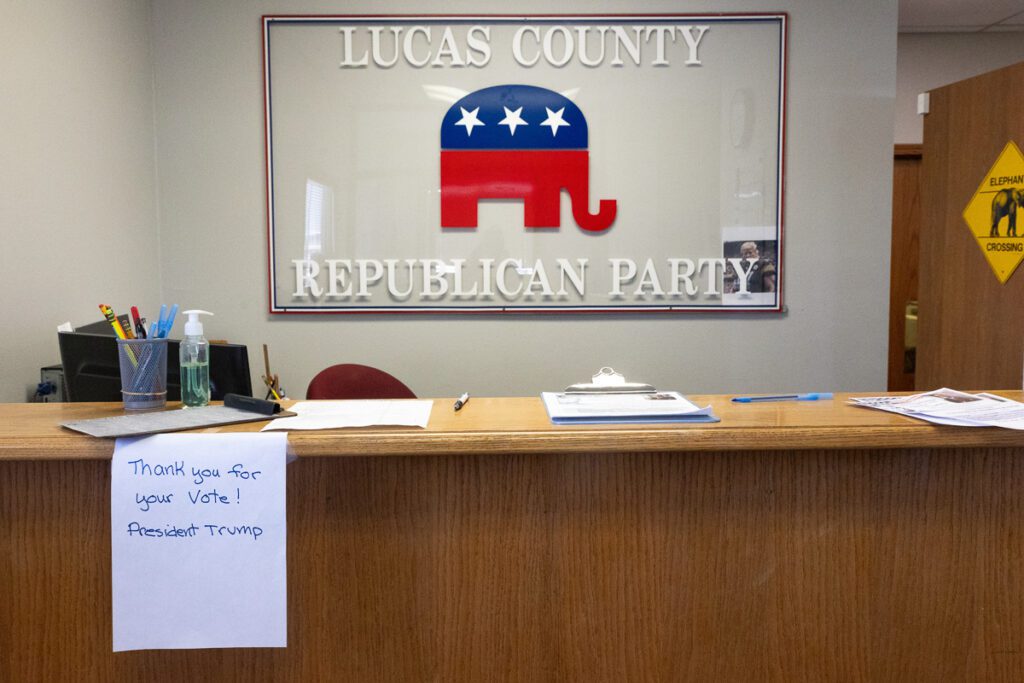
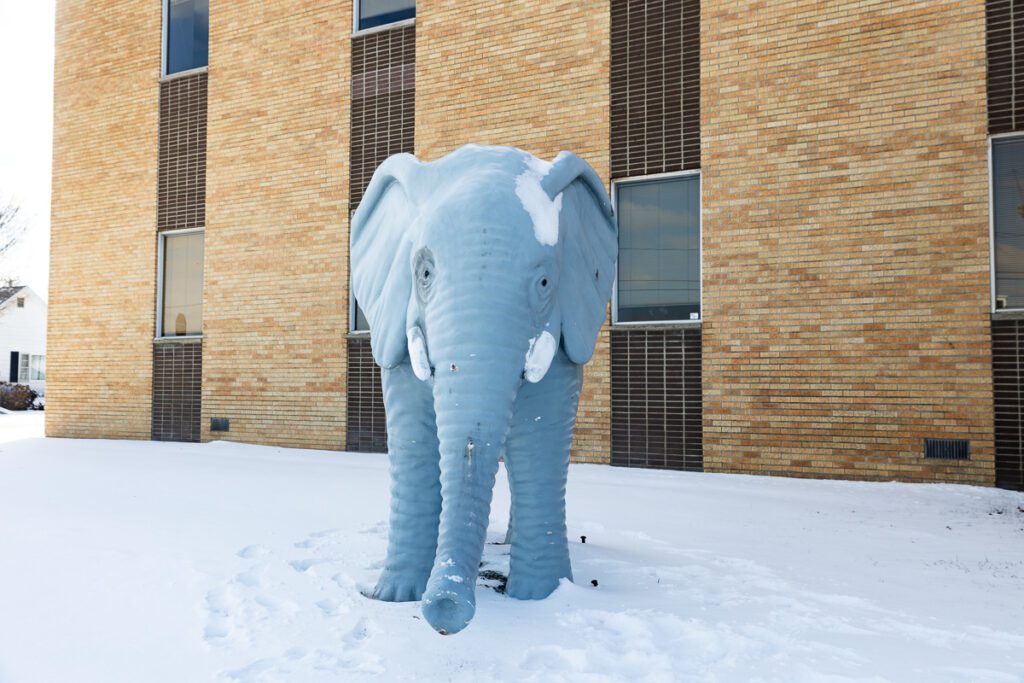
The Toledo Free Press was denied permission to photograph or interview participants taking part in the festivities, which lasted from 1 p.m. to 4 p.m., the same relative timeline the protesters were out in front of 1 Government Center.
While the Republicans had a colloquial get-together, where people had a pre-existing familiarity with one another, the coalition in front of the government building was a mixed bag of mostly strangers.
Some represented themselves, while others were members of groups, like the Northwest Ohio Peace Coalition, Veterans for Peace and Toledo Persists, all concerned citizens who turned out in conjunction with protests across the nation.
This is a great way to activate, organize, get together and see how many people are like-minded, [who] feel just as angry and can yell, in a healthy way, while also sharing other ways to volunteer, to donate, [to share] what organizations are actually doing the work.
Colby Buzzell, of Perrysburg, Ohio
“The voters are getting exactly what they voted for,” Musk said, brushing off concerns about any conflicts of interest he may have from receiving $18 billion in contracts from the Pentagon.
“All of our actions are fully public,” he said referring to the DOGE website, which has three main categories in the navigation bar that relate to the federal government: Savings, Workforce and Regulations.
“Savings” appears to be the most integral navigation section on the website, offering a large sweeping view of contracts for each respective agency. A number of the contracts are listed as offering no savings at all, meaning nothing was cut, while others offer millions of dollars in savings.
“Competence and caring will cut the budget deficit in half,” Musk said, and estimated that by 2026 there will be no more inflation in the U.S. at all.
At the same time, he said DOGE was “…moving fast so we will make mistakes, but we’ll correct the mistakes very quickly.”
But the answer for transparency seems to be vague at the very least, as Musk’s DOGE employees have largely remained anonymous, except for Marko Elez, 25, who resigned after being doxed and having incredibly racist tweets come to light.
Behaviors like these, including Musk’s alleged Sieg Heil at Trump’s inauguration, have sewn distrust among skeptics of Musk, and have caused backlash in Europe, causing Tesla sales to plummet there.
And while the DOGE website includes a list of contracts with different government agencies, the organization of the contracts seems to be organized thematically. The termination of news outlet subscriptions is organized towards the top of the page, regardless of date, but the information is not organized or organizable by date, amount of money saved, or by government department.
When looking into the specific contracts, the reasons for cutting funds are not evident, just that they are happening.
Boiler plate terms like, “TERMINATE FOR CONVENIENCE” or “FUNDING ONLY ACTION” are listed as the reason for modification of the contracts.
An almost $16 million contract with USAID given to DEMOCRACY INTERNATIONAL, INC for training conflict and violence negotiators was cut by nearly $14 million without a full sentence to explain why.
Musk admitted in the Oval Office presser that a previous claim to send $50 million of condoms to Gaza was incorrect, and said, “Some of the things I said will be incorrect and should be corrected.”
But the lack of transparency in the process of cutting the government – and Musk’s cavalier attitude towards making mistakes – have not exactly reassured Americans who are suspicious of him.
“10s of 1,000s of federal employees that have been fired; the only one the administration has spoken out for was one from DOGE, who resigned for racist tweets. So you see who the government’s looking out for,” Ryan McConnell said during the Toledo protest.
“It’s just a bad situation. Abolishing agencies that help people, like the Consumer Financial Protection Bureau, USAID, targeting all these agencies that were investigating Musk. They [the Trump administration] have an unelected billionaire, basically the richest man on the planet, basically running the government however he sees fit,” he complained.
Elections and results
Ultimately, the voters did choose Trump, who won the 2024 election with 49.87 percent of the vote.
A recent Gallup Poll showed that within Trump’s first week in office, there was a 91 percent approval rate amongst Republicans, 6 percent approval among Democrats and 46 percent among Independents. That first week included big changes in the government, including pulling out of the Paris Accords, pulling out of the World Health Organization and attempting to get rid of birthright citizenship.
More recently, a CBS poll showed 50 percent or higher support for Trump on most issues, except for America taking over Gaza, with only 13 percent approval, and only 23 percent of people saying Musk should have an integral role in government operations. A more popular conclusion was that Musk should have some role in the government, with over 50 percent of people saying he should have some, to a lot of, a role in what’s going on.
But Lucas County is not indicative of the rest of the United States, or even Ohio. Kamala Harris won the popular vote in Lucas County with 55.23 percent of the vote – 106,320 votes to Trump’s 82,398 – at 42 percent.
When asked about Trump’s alleged overreach of power, Orange replied, “I’m not a constitutional authority,” and wished not to comment on DOGE, the layoffs or on any ways the judicial branch had blocked Trump’s actions.
Well, I would like to see where the waste and fraud is within our government, no matter where it is, no matter who it is, whether it’s Republican or Democrat or Independent.
Barbara Orange, chair of the Lucas County Republican Party
And while declining to comment on specifics, Orange said, “I do have a general trust in what his [Trump’s] ultimate goals are, to put America first and correct a lot of things that have gone wrong for probably many years.”
Some Americans trust Trump, mostly those who voted for him, to sort out the details of a chaotic month-long series of cutting actions, while others find it impossible to do so.
“When they talk about these fraudulent spending things with USAID, it’s not fraud so much as some policies they disagree with,” McConnell said.
“You can have the conversation of saying where the money should be going, but just axing an agency that helps 10s of 1,000s, if not hundreds of 1,000s, people worldwide is not the solution. And they’re calling it one thing when it really is another.”
McConnell went on to say the gutting of the government with the cover of rooting out fraud seemed to be a facade to make space for Trump’s new proposed tax cuts for the rich.
The 2017 Tax Cuts and Jobs Act passed during Trump’s first term is set to expire at the end of December 2025, and, if made permanent, the changes to taxes could severely increase the deficit.

